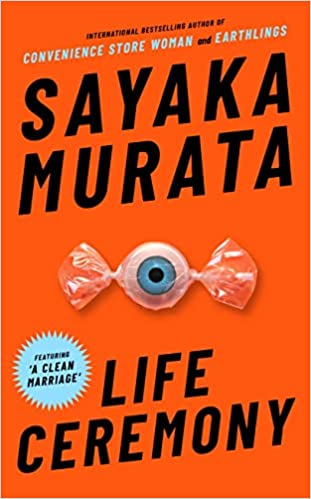
This is a really thought-provoking collection. Sayaka Murata has a way of shifting the ground beneath your feet without you really noticing. Suddenly you look around the fictional landscape and realise it works in ways you really hadn’t considered and these ways reflect on the real landscape and make you question your assumptions there too.
Most of the stories have domestic settings that look at the finer details of relationships between couples, close family, friends and coworkers. What humans eat, wear, fuck and what is considered normal or acceptable, is Murata’s territory, from a world in which people are turned in useful objects at their death – ‘A First Rate Material’ – , to a world in which it is normal to eat the flesh of the recently departed as part of a life ceremony in which the old life gives birth to the new as people couple off and copulate in the streets – ‘Life Ceremony’ – every story introduces an element of the unfamiliar into the meticulously observed detail of daily life. It is the stories that humans tell that justify their behaviors and make them acceptable to others. We can understand how children might care for a dog that is really a middle-aged salaryman (‘Poochie’) but can we understand grown-ups admiring human bone wedding rings (‘A First Rate Material’), or two women living together and bringing up children as friends, not lovers (‘Two’s Family’)? Where does our ability to accept cultural shifts end? What is reality?
This investigation of shared truth is one that I delight in.
In ‘Life Ceremony’ one of the characters talks about loving Disneyland. He says, “Nobody ever mentions the person inside the cartoon-character costume, do they? Everyone’s lying a bit. That’s what makes it a dream country. Our world isn’t any different, is it? Everyone keeps telling little lies, and that’s how the mirage is created. That’s why it’s beautiful – because it’s a momentary make-believe world.”
When asked by the protagonist what that makes the real world, he says, “It’s the mirage that’s real. All our little lies are gathered together and become a reality that you can see only now.”
It’s an idea picked up on in ‘Hatchling’ where the main character is nervous of her upcoming wedding because she doesn’t know how to hold a ceremony in which all of her friends from different settings – school, college and two different jobs – will be there expecting a different version of her. In each situation she behaves differently, has a different nickname and even speaks differently. How can she be all of these things at once without seeming insincere? How can she unify all these personalities, all these sides of herself, sides that evolve from simply responding to the expectations of those around her? Is she lying about who she is to each of these different groups, or can she be all of these people at once? Perhaps a new personality is needed to make sense of all of these combined?
Stories and consumption are the survival musts of a collection that questions the nature of the individual and how individuals come together to form societies and cultures. It’s a fun and unnerving set of stories sure to enchant.
I’ll be reviewing Moonlight and the Pearlers Daughter by Lizzie Pook next.